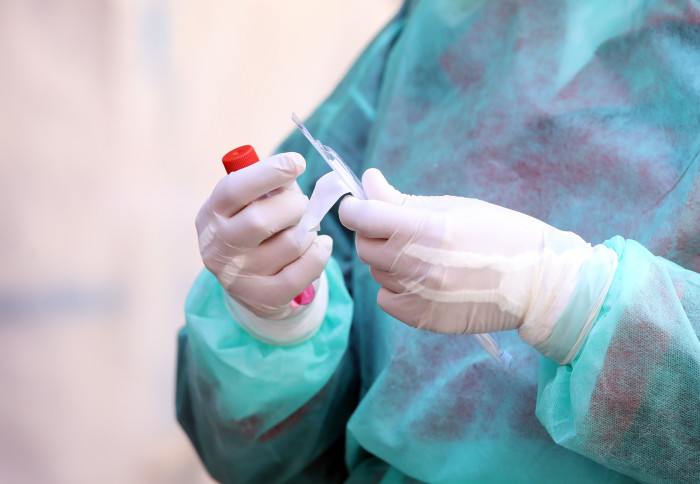Community coronavirus infections growing nationally, REACT study shows

The latest report from the largest home COVID-19 testing study has shown that infections are continuing to rise in England as 1 in 170 test positive.
An analysis of swab tests taken by 175,000 people between 18th September and 5th October found that the virus is infecting around 45,000 people each day.
The research, led by Imperial College London, reports that 0.60% of the population, or 60 per 10,000, had the SARS-CoV-2 virus, compared to 0.13% in the previous round of testing.
"Our robust findings paint a concerning picture of the growing epidemic across England." Prof Paul Elliott REACT programme director, Imperial
While infections are rising nation-wide, substantial differences were found at the regional level and the study identified a number of virus hotspots, with the highest levels of prevalence identified in the North West, Yorkshire and the Humber and the North East.
Young people aged 18-24 were most likely to test positive for the virus, with 1 in 80 estimated to be infected. Rates were also found to be rising fastest in people aged 65 and above, which saw 8 times as many infections compared to the previous report.
These results follow an interim report released last week, which included data from the first 80,000 swabbed for the study period.
The findings from the REal-time Assessment of Community Transmission (REACT 1) programme are available in a pre-print report and will be submitted for peer-review.
Professor Paul Elliott, Director of the REACT programme at Imperial, from the School of Public Health, said: “Our robust findings paint a concerning picture of the growing epidemic across England. While certain areas are worse affected, if left unabated then infection trends will follow nation-wide and could lead to high levels of unnecessary death and illness from the disease.”
Regional variation
The REACT 1 study is tracking present levels of coronavirus infection in the community by testing more than 150,000 randomly-selected people each month over a two-week period. Participants are chosen from GP lists to ensure a nationally-representative sample. Volunteers take nose and throat swabs at home, which are then analysed in a laboratory by a technique called RT-PCR.
"The scale of our ongoing study means that we can offer granular detail on how the epidemic is changing in England over time, identifying communities and areas that are worst affected." Prof Steven Riley Professor of Infectious Disease Dynamics, Imperial
Out of 174,949 swabs analysed, 824 tested positive for the virus, giving an average national prevalence of 0.60%, corresponding to approximately 1 in 170 people having the virus at any one time. At the national level infections were found to be doubling every 29 days, with an R rate of 1.16 and a possible range between 1.05 and 1.27. This means that on average, 10 infected people would pass the virus on to about 12 others.
With a high number of positive swabs, the researchers were able to estimate the R number across different geographical areas. They showed that R was not even across the country, with the highest rates in Yorkshire and the Humber, West Midlands and the North West (1.37, 1.33 and 1.27, respectively). For London R was 0.97.
Prevalence was also found to vary regionally, highest in the North West (1.02%), North East (0.91%), and Yorkshire and The Humber (0.63%). The lowest rates were found in the South East at 0.25%. London had a prevalence of 0.45%.
Professor Steven Riley, study author and Professor of Infectious Disease Dynamics at Imperial, said: “The scale of our ongoing study means that we can offer granular detail on how the epidemic is changing in England over time, identifying communities and areas that are worst affected. This resolution is critical to enable an agile and timely public health response.”
Uneven impact
The findings also showed that the virus is disproportionately affecting some groups. The highest rates were found in Asian people, who were twice as likely as white people to test positive (0.9% vs 0.45%). Black people also had a high prevalence of infection at 0.73%.
In addition, the research identified a link with household size and deprivation, where prevalence was highest in those living in households of 6 or more (over 0.8%) and the poorest areas (0.77%).
By age, prevalence was highest in those aged 18-24 at 1.21%. In those aged 65 and above, prevalence increased 8-fold from 0.04% to 0.33% compared to the last report.
Tracking the coronavirus pandemic
"I'd like to encourage those who receive letters from us for the next round to take part so we can again have a set of strong results to help support government decision making." Kelly Beaver Managing Director - Public Affairs, Ipsos MORI
The REACT programme is a series of studies that are monitoring how the virus is spreading across the country. Commissioned by the Department of Health and Social Care, it is being carried out in partnership with Ipsos MORI and Imperial College Healthcare NHS Trust.
Kelly Beaver, Managing Director - Public Affairs at Ipsos MORI said: “We have seen a huge response this round with over 175,000 people taking part in this round which is hugely appreciated. The results from this study are so important during the pandemic and so I’d like to thank all of those who have taken part and .”
A separate arm of the programme, REACT 2, is using antibody finger-prick tests to monitor past infections across England. The results of the first 100,000 people tested have already been announced and findings from the next round, involving another 100,000 people, are expected soon.
Article supporters
Article text (excluding photos or graphics) © Imperial College London.
Photos and graphics subject to third party copyright used with permission or © Imperial College London.
Reporter
Justine Alford
Institute of Global Health Innovation